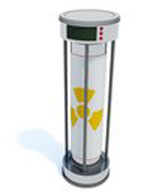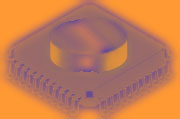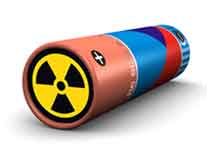Nuclear
Accelerated Generator
(NAG) harvest
Isotope
beta minus electrons (Atomic
Battery)
Welcome
to the Executive Engineering
webpage on Atomic Batteries (NAGs)
These are the only
pages that are accessible to the Public for viewing of
NAG information



INTRODUCTION
This page is set up exclusively for readers of Defense Electronics Magazine "October Issue" and you have presumably come here through a link from there. Our purpose here is to give you a brief, plain language overview of the Nuclear Accelerated Generator (NAG) and then give you the means to get further, detailed information.
BACKGROUND
At its heart, the NAG is a fully scalable device designed to provide years of trouble-free electrical power for any application, large or small. It is the result of years of experimentation as well as the application of newly-developed industrial materials and technology. As a result, we can confidently state that we have achieved an unprecedented milestone in the production of electrical power.
Powered by nuclear isotopes, the NAG is fully capable of generating both exceedingly large and exceptionally small amounts of electrical power and to do it more efficiently, over a longer period of time and with fewer breakdowns than any conventional technology currently in use. Because of the unique traits of the NAG, Executive Engineering feels that it has a wide range of uses in the military, civilian and industrial sectors. For instance:
MILITARY
The United States military depends, to a large extent, on the use of high-technology devices to maintain superiority over potential enemies. This technology, whether utilized by individual soldiers on the ground or by jet planes, tanks, radar, field hospitals or whatever, requires the use of huge amounts of fuel, batteries, generators and other means to produce electrical power. Individual soldiers are often loaded down with batteries for their night vision scopes, laser sights, radios, computers, etc and larger vehicles are often followed into battle with convoys of fuel trucks.
The use of NAG devices by military units would virtually eliminate dependence on conventional power sources such as fuel cells, solar cells, fossil fuel engines and diesel engines. Not only would the NAG devices eliminate all these technologies but it would do it more efficiently and less expensively than allowed for by current technology.
LARGE-SCALE CIVILIAN
Likewise the civilian sector could make good use of the NAG technology. Since the NAG device is fully scalable and can be engineered to run extremely large applications, it could produce power for entire cities or rural areas without any dependence on traditional nuclear or fossil fuels. Further, since it is not, at its core, a heat producing device, it is safe, reliable and extremely efficient. It can produce power for the grid at a fraction of the cost of traditional plants and with far greater efficiency than anything now in use. As well, since it has no moving parts and does utilize nuclear reactions, it is far safer than any other technology and it has, relatively speaking, a very small footprint.
MEDIUM-SCALE CIVILIAN
Smaller applications could also benefit from the NAG technology. For instance large business, medical or industrial complexes could have their own NAG generator producing power all without dependence on traditional fuels. The high efficiency of the NAG would make such power both safe and economical. Just as an aside, it should be pointed out that a complex powered by a NAG device could, and should, sell back to the grid power that is not needed by the complex. For instance, an industrial complex that is closed during the night could sell back to the grid (for a profit) any electrical power produced at that time period.
REMOTE SENSORS
Remote sensors are one of the more obvious uses of the NAG devices. For instance inaccessible sensors located on the ocean floor or on top of mountains could be safely and dependably powered for years by small NAG devices.
TRANSPORTATION APPLICATIONS
The transportation industry is also a likely candidate for NAG use. Large trucks, buses and trains could all be powered by NAGs. Utilization of NAG-powered engines would allow such vehicles to run for years without and dependence on fossil fuels or, for that matter, without needed to be refueled for years at a time. As with industrial complexes, we can foresee that such vehicles could plug into the power grid when they are not operating and sell unused electrical power back to the power companies for profit, thus adding to their overall efficiency and cost effectiveness.
MEDICAL APPLICATIONS
Medical uses of the NAG technology are quite feasible. Many small and innovative artificial limbs and other prosthetic devices are being fitted onto people with various disabilities and medical conditions and most of them use battery-supported electrical power. These batteries have notoriously short life spans and are bulky and heavy. NAGs could easily support these medical devices for years without replacement.
NAG ATTRIBUTES
The NAG units are entirely self-contained. That is, there is no dependence on outside fuel or power sources. There is no need to fill them with fossil fuel or to replace their batteries periodically. Depending on the isotope being used for a particular application, they could run anywhere from a few years to a few hundred years safely and efficiently.
The NAG is not designed, in and of itself, to produce heat for power as are conventional nuclear plants nor does it produce any external emissions. It is, therefore, safe for the environment, generally, and it is safe for use in places that conventional nuclear power plants could never operate. Safety is always a concern in any operation and, compared to conventional nuclear power plants, the NAG device is one of the safest mechanisms on the planet. It cannot melt down, explode or even use the isotopic fuel to make a bomb.
FINAL NOTE
This article is intended to offer a preview of the Nuclear Accelerated Generator (NAG). It is not meant to be anything like an all-inclusive report on how it has been developed and how it would be manufactured. What we have tried to do here is to whet the appetite for more specific, scientific information. At least some of that information is now available for the first time, exclusively to readers of Defense Electronics magazine. If you will provide us an e-mail containing your name, your company, your title and a business phone number, we will attempt to answer whatever questions you may have concerning the Nuclear Accelerated Generator. In this way we can set up an appointment to more fully explore the specific science concerning the NAG or we can even answer your questions via e-mail. Due to the highly sensitive information contained in the product information, this is the only way we can proceed at this time.
The Nuclear Accelerated Generator is, in its entirety, 100% the proprietary intellectual property of Executive Engineering of Florida.
| For access to full disclosure you must contact SUPPORT by E-Mail at Executive Engineering! |
| Method | Cents/kW-h | Limitations and Externalities |
| Nuclear NAG Currently supplies 0% of the global electricity demand. |
0.5 -2.5 Cents/kW-h |
Fuel for the NAG is plentiful and, since it actually consumes nuclear waste, it creates no additional nuclear waste problems. Direct Energy Conversion From Nuclear Waste. The NAG produces 40 times more power than current thermal nuclear RTG technology @ 3%. Power Conversion Rate of a NAG Atomic Battery @ ~85% efficient depending on isotopes used. Converter size is extremely small and light weight. Fuel Life 3-200 years @ ~ $20.00 per watt unit of isotope. " Note: The NAG is capable of producing power at less cost than gasoline when gasoline was selling for $2.25 per gallon. The
EENAG's are DC Atomic Battery Systems.
They consist of an Atomic Charging Core (Nuclear
Accelerated Generator) and a Lithium Battery that
receives a specific charge over a period of time. They are
safe, pose no health hazard and have no harmful radiation
that can be detected outside the battery. These batteries
can be custom-designed and have a useful power output of several
minutes or hours at their peak power. Potential uses would include
sensors, cell phones, computers or any other electronic and / or
electrical equipment requiring dependable, long-life batteries.
|
| Natural Gas Currently supplies around 15% of the global electricity demand. |
3.9 - 4.4 Cents/kW-h | Gas-fired plants are generally quicker and less expensive to build than coal or nuclear facilities, but a relatively high percentage of the cost/KWh is derived from the cost of the fuel. Due to the current (and projected) upwards trend in gas prices, there is uncertainty concerning the cost / KWh over the lifetime of such plants. Gas burns more cleanly than coal but the gas itself (largely methane) is a potent greenhouse gas. Some energy conversions to calculate your cost of natural gas per kwh. 100 cubic feet (CCF)~ 1 Therm = 100,000 btu ~ 29.3 kwh. |
| Coal Currently supplies around 38% of the global electricity demand. |
4.8 - 5.5 Cents/kW-h | It is increasingly difficult to build new coal plants in the developed world due to environmental requirements governing the plants. There are growing growing concerns about coal-fired plants in the developing world. China, for instance, imposes less environmental overhead, and has large supplies of high sulfur content coal. The supply of coal is plentiful but the coal generation method is perceived to make larger contributions to air pollution than the rest of the methods combined. Coal-fired plants contribute 50 tons of mercury to the environment annually. |
| Nuclear Thermal Currently supplies around 24% of the global electricity demand. |
11.1 - 14.5 Cents/kW-h | There are huge political difficulties in using nuclear energy in some nations and great risk of widespread (and potentially lethal) contamination upon containment failure. Fuel is plentiful, but problematic. Waste disposal remains a significant and growing problem, and de-commissioning plants is costly (averaging approximately US $320M per plant in the US). |
** "Watt Unit of Isotope" , is a coined term that Executive Engineering has developed for electrical power conversion of an isotope over a time period.